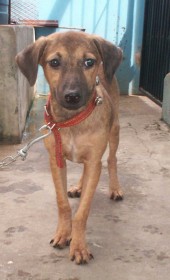Last week I suggested the use of an enema to help evacuate impacted faeces.
An enema is an infusion of a liquid into the lower intestine (rectum, colon) by way of the anus. The recommended dosage rate of an enema is one ounce of fluid for 10 pounds of the animal’s body weight. Lots of people recommend soap water as an enema, and I have used it successfully together with glycerine early in my career as a vet.
Schools taught even then that soap water should not be used, especially if the animal has a kidney or liver problem. Nowadays, there are many products on the market, the most common of which is ‘Fleet,’ which can be purchased over the counter. It comes with a very handy nozzled tip.
If it becomes very necessary for you to intervene on your own, then I suppose you can use the soap water/glycerine combination.
In that case, please use a plastic bottle with an attached stiff, but pliable rubber tube or nozzle. Lubricate the tube/nozzle well and insert it into the rectum.
I should mention that ordinary warm water or an isotonic saline solution could be used. You would then insert a rubber catheter which is attached to an enema bag. This you would insert into the rectum, so far up as to impede the water falling back out.
Let’s look at some examples of the different types of laxatives:

Emolllient laxatives
Docusate sodium – (cats: a 50mg capsule once daily: dogs (according to size): four 50mg capsules daily)
This mild laxative works by retaining water in the intestine and thereby softening the faeces as the latter absorbs the water.
Osmotic laxative
Lactulose – (dogs and cats: 0.5 ml/kg body weight, every 8 -12 hours)
Stimulant laxatives
Bisacodyl – (cats: 5 mg daily; dogs: 5 – 20mg daily, according to weight).
NB (1) These stimulant laxatives are not to be used if there is foreign body obstructing
the bowel.
(2) Do not give laxatives regularly/routinely.
Finally, I would suggest the following as supportive therapy:
(1) Affected animals should be adequately hydrated and have continuous and ready access to water.
(2) If dehydrated, fluid and electrolyte infusions must be given (coconut water, oral rehydration salts, etc)
(3) Continuous or long term use of laxatives should be discouraged
(4) The dog must have the possibility of going out several times a day to relieve itself.
I know someone will ask about the usage of cascara, senna pods and castor oil. Well, I am a strong advocate of these natural laxatives/stool softeners, but you must contact your vet who will advise on the dosage rates after assessing the situation.
Next week, we will discuss the surgical option relative to an animal with impactions in the large intestine.
Please implement disease preventative measures (vaccinations, routine dewormings, monthly anti-heartworm medication, etc) and adopt-a-pet from the GSPCA’s Animal Clinic and Shelter at Robb Street and Orange Walk, if you have the wherewithal to care well for the animals. Do not stray your unwanted pets, take them to the GSPCA’s Clinic and Shelter instead. If you do not wish your pet to have puppies or kittens, you may exploit the GSPCA’s free spay and neutering programme. If you see anyone being cruel to an animal, or if you need any technical information, please get in touch with the Clinic and Shelter by calling 226-4237.





